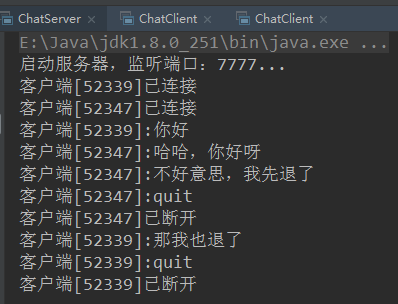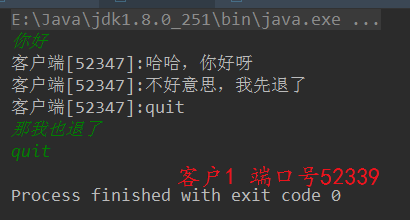(六)NIO聊天室实战
1. NIO模型分析

对于服务端,创建Selector,需要监听ServerSocketChannel的ACCEPT事件,监听注册的每一个SocketChannel的READ事件。
- Selector监听ACCEPT事件,如果有客户发出连接请求,服务端要为该客户的通道在服务器Selector注册READ事件。
- Selector监听READ事件,即监听所注册客户的SocketChannel上是否有可读的数据。
对于客户端,也要创建Selector,这里监听的事件为SocketChannel的CONNECT事件 和 READ事件。
-
- Selector监听CONNECT事件,直到连接完全建立后,为客户在selector上注册READ事件。
- Selector监听READ事件,目的是监听服务器转发来的消息。
2.实验结果



3.完整代码
3.1服务器
public class ChatServer { private static final int DEFAULT_PORT = 8888; private static final String QUIT = "quit"; private static final int BUFFER = 1024; private ServerSocketChannel server; private Selector selector; // 从ServerSocketChannel中读取客户端发来的消息。相对应,从客户角度,即要把数据写入该buffer private ByteBuffer rBuffer = ByteBuffer.allocate(BUFFER); // 实现消息转发时,把消息写入到其他客户的SocketChannel private ByteBuffer wBuffer = ByteBuffer.allocate(BUFFER); private Charset charset = Charset.forName("UTF-8"); private int port; // 存储用户自定义的服务器端口 public ChatServer() { this(DEFAULT_PORT); } public ChatServer(int port) { this.port = port; } private boolean readyToQuit(String msg) { return QUIT.equals(msg); } private void close(Closeable closeable) { if (closeable != null) { try { closeable.close(); } catch (IOException e) { e.printStackTrace(); } } } private String getClientName(SocketChannel client) { return "客户端[" + client.socket().getPort() + "]"; } // 从客户通道上读取消息 private String receive(SocketChannel client) throws IOException { rBuffer.clear(); // 因为rBuffer是类变量,每次调整指针,以清空消息 // 写入到rBuffer,read()返回的是本次读到了多少字节 while (client.read(rBuffer) > 0); rBuffer.flip(); // 写模式变为读模式 return String.valueOf(charset.decode(rBuffer)); } // 转发消息 private void forwardMessage(SocketChannel client, String fwdMsg) throws IOException { // 注意区分selectedKeys() 和 keys(), // 前者返回所有触发了的事件所对应的SelectionKey的集合,后者返回目前所有注册到selector上的SelectionKey的集合 for (SelectionKey key : selector.keys()) { Channel connectedClient = key.channel(); if (connectedClient instanceof ServerSocketChannel) { continue; } if (key.isValid() && !client.equals(connectedClient)) { wBuffer.clear(); wBuffer.put(charset.encode(getClientName(client) + ":" + fwdMsg)); // 向wBuffer写数据 wBuffer.flip(); // 变为读模式 while (wBuffer.hasRemaining()) { ((SocketChannel)connectedClient).write(wBuffer); // 疑问:为什么不用检测客户channel是否处于WRITE状态? } } } } // 服务器需要处理两种事件,ACCEPT 和 READ // 疑问:为什么不用监听WRITE事件??? private void handles(SelectionKey key) throws IOException { // ACCEPT事件 —— 和客户端建立了连接 if (key.isAcceptable()) { // 获取ServerSocketChannel ServerSocketChannel server = (ServerSocketChannel) key.channel(); // 获取对应客户端的SocketChannel SocketChannel client = server.accept(); client.configureBlocking(false); // 由默认的阻塞式转换为非阻塞式 // 把客户注册在Selector上,监听READ事件 client.register(selector, SelectionKey.OP_READ); System.out.println(getClientName(client) + "已连接"); }else if (key.isReadable()) { // READ事件 —— 客户端发送了消息 SocketChannel client = (SocketChannel) key.channel(); String fwdMsg = receive(client); if (fwdMsg.isEmpty()) { // 客户端异常 key.cancel(); // 取消掉,使selector不要再监听这个通道的READ事件了 selector.wakeup(); // 通知selector,监听的状态发生了改变 } else { System.out.println(getClientName(client) + ":" + fwdMsg); forwardMessage(client, fwdMsg); // 检查用户是否退出 if (readyToQuit(fwdMsg)) { key.cancel(); selector.wakeup(); System.out.println(getClientName(client) + "已断开"); } } } } private void start() { try { // 创建ServerSocketChannel,默认处于阻塞式调用 server = ServerSocketChannel.open(); // 确保ServerSocketChannel处于非阻塞式状态 server.configureBlocking(false); // 把通道所关联的socket绑定监听端口 server.socket().bind(new InetSocketAddress(port)); selector = Selector.open(); // 让selector对象监听创建ServerSocketChannel上的ACCEPT事件 server.register(selector, SelectionKey.OP_ACCEPT); System.out.println("启动服务器,监听端口:" + port + "..."); while (true) { selector.select(); // select()函数的调用是阻塞式的,直到所监听的通道的事件触发了,才会返回 // selectionKeys中包含了一次调用select(),selector监听到的所触发所有事件的信息 Set<SelectionKey> selectionKeys = selector.selectedKeys(); for (SelectionKey key : selectionKeys) { // 处理被触发的事件 handles(key); } selectionKeys.clear(); // 已经处理过的,要手动清空 } } catch (IOException e) { e.printStackTrace(); } finally { close(selector); // 关闭selector之前,也自动关闭了注册到selector上的事件对应的通道 } } public static void main(String[] args) { ChatServer chatServer = new ChatServer(7777); chatServer.start(); } }
3.2客户端
public class ChatClient { private static final String DEFAULT_SERVER_HOST = "127.0.0.1"; private static final int DEFAULT_SERVER_PORT = 8888; private static final String QUIT = "quit"; private static final int BUFFER = 1024; private String host; private int port; private SocketChannel client; private ByteBuffer rBuffer = ByteBuffer.allocate(BUFFER); private ByteBuffer wBuffer = ByteBuffer.allocate(BUFFER); private Selector selector; private Charset charset = Charset.forName("UTF-8"); public ChatClient() { this(DEFAULT_SERVER_HOST, DEFAULT_SERVER_PORT); } public ChatClient(String host, int port) { this.host = host; this.port = port; } public boolean readyToQuit(String msg) { return QUIT.equals(msg); } private void close(Closeable closeable) { if (closeable != null) { try { closeable.close(); } catch (IOException e) { e.printStackTrace(); } } } private void handles(SelectionKey key) throws IOException { // 处理CONNECT事件 - 连接就绪事件 if (key.isConnectable()) { SocketChannel client = (SocketChannel) key.channel(); if (client.isConnectionPending()) { // 如果为false,说明连接还不能完全建立,需要等待 client.finishConnect(); // 完成建立连接的过程 // 使用额外线程处理用户的输入 new Thread(new UserinputHandler(this)).start(); } client.register(selector, SelectionKey.OP_READ); }else if (key.isReadable()) { // READ事件 - 服务器转发消息 SocketChannel client = (SocketChannel) key.channel(); String msg = receive(client); if (msg.isEmpty()) { // 服务器异常 close(selector); }else { System.out.println(msg); } } } private String receive(SocketChannel client) throws IOException { rBuffer.clear(); // 写入到rBuffer,read()返回的是本次读到了多少字节 while (client.read(rBuffer) > 0); rBuffer.flip(); return String.valueOf(charset.decode(rBuffer)); } // 发送消息给服务器,让服务器转发给其他人 public void send(String msg) throws IOException { if (msg.isEmpty()) { return; } wBuffer.clear(); wBuffer.put(charset.encode(msg)); wBuffer.flip(); while (wBuffer.hasRemaining()) { client.write(wBuffer); } // 检查用户是否退出 if (readyToQuit(msg)) { close(selector); } } private void start() { try { client = SocketChannel.open(); client.configureBlocking(false); // 改为非阻塞状态 selector = Selector.open(); // CONNECT: SocketChannel已经与服务器建立连接的状态 client.register(selector, SelectionKey.OP_CONNECT); // 向服务器发送连接请求 client.connect(new InetSocketAddress(host,port)); while (true) { selector.select(); Set<SelectionKey> selectionKeys = selector.selectedKeys(); for (SelectionKey key : selectionKeys) { handles(key); } selectionKeys.clear(); } } catch (IOException e) { e.printStackTrace(); } catch (ClosedSelectorException e) { // 用户正常关闭 } finally { close(selector); } } public static void main(String[] args) { ChatClient client = new ChatClient("127.0.0.1",7777); client.start(); } }
public class UserinputHandler implements Runnable{ private ChatClient chatClient; public UserinputHandler(ChatClient chatClient) { this.chatClient = chatClient; } @Override public void run() { try { // 等待用户输入消息 BufferedReader consoleReader = new BufferedReader( new InputStreamReader(System.in) ); while (true) { String input = consoleReader.readLine(); // 向服务器发送消息 chatClient.send(input); // 检查用户是否准备退出 if (chatClient.readyToQuit(input)) { break; } } } catch (IOException e) { e.printStackTrace(); } } }


 浙公网安备 33010602011771号
浙公网安备 33010602011771号